© Copyright Atlanta Coin Expositions, 2008-2025. All Rights Reserved.
Several of the links on the pages within this web site go to affiliate vendors.
A vendor affiliation can mean a small monetary compensation to the web site owner at no additional cost to you.
Several of the links on the pages within this web site go to affiliate vendors.
A vendor affiliation can mean a small monetary compensation to the web site owner at no additional cost to you.
Coin Show
Information
Shop
General
Next Monthly Coin Show
Coin Show - Monthly Notes from April 2019
Official Red Book 2020
Great Atlantic and Pacific Tea Company
Lehigh and Lackawanna Railroad Company
1955 Doubled Die Lincoln Cent
That's the tour for this month.
As usual, these examples barely scratch the surface of the many different collectibles found on the bourse each month.
Our regular and visiting dealers display a broad variety of coins, currency, bullion and other collectibles for visitors to enjoy.
Many of our dealers also buy and sell between the monthly shows and bring their newly acquired treasures to display providing new and intriguing items for visitors to discover.
Mark your calendars and visit the next Greater Atlanta Coin Show on Sunday, May 5, 2019 in the Joe Mack Wilson ballroom to buy, sell, trade or just browse among the treasures on display.
As usual, these examples barely scratch the surface of the many different collectibles found on the bourse each month.
Our regular and visiting dealers display a broad variety of coins, currency, bullion and other collectibles for visitors to enjoy.
Many of our dealers also buy and sell between the monthly shows and bring their newly acquired treasures to display providing new and intriguing items for visitors to discover.
Mark your calendars and visit the next Greater Atlanta Coin Show on Sunday, May 5, 2019 in the Joe Mack Wilson ballroom to buy, sell, trade or just browse among the treasures on display.

The April 2019 Greater Atlanta Coin Show included a full bourse with many visitors enjoying the dealers and their showcases of coins, bullion, currency and other collectibles.
We appreciate all of you who visited, and we, of course, appreciate our dealers, our security and the hotel's staff for continuing to make the monthly coin show a busy and fun place to spend a few hours.
For April, the weather generated a thunderstorm in the wee hours of the morning, but the day became mostly sunny with a few overcast skies and temperatures in the low 80s.
We appreciate all of you who visited, and we, of course, appreciate our dealers, our security and the hotel's staff for continuing to make the monthly coin show a busy and fun place to spend a few hours.
For April, the weather generated a thunderstorm in the wee hours of the morning, but the day became mostly sunny with a few overcast skies and temperatures in the low 80s.
The overnight thunderstorm helped clear some of the pollen from the air, but the yellow dust from the pines continued to coat anything in its path.
People out and about also enjoyed Mother Nature's show of her springtime colors in the flowering trees, shrubs and plants along with the spring green of the new leaves on the trees.
As usual, the show shared the hotel with at least one if not more church groups that hold services in the hotel's meeting rooms.
The show's next door neighbor in the remainder of the Joe Mack Wilson ballroom presented material to their attendees for flipping houses. No, we didn't hear what they had to say.
For some humor, we observed a Jaguar in the hotel's parking lot with the vanity tag of BOND 007. Wonder if it's a personal car for Mr. or Ms. Bond or if it's a business car.
For our virtual tour this month, let's take a look at a variety of items on the bourse from a book to stock certificates to coins to a rock.
People out and about also enjoyed Mother Nature's show of her springtime colors in the flowering trees, shrubs and plants along with the spring green of the new leaves on the trees.
As usual, the show shared the hotel with at least one if not more church groups that hold services in the hotel's meeting rooms.
The show's next door neighbor in the remainder of the Joe Mack Wilson ballroom presented material to their attendees for flipping houses. No, we didn't hear what they had to say.
For some humor, we observed a Jaguar in the hotel's parking lot with the vanity tag of BOND 007. Wonder if it's a personal car for Mr. or Ms. Bond or if it's a business car.
For our virtual tour this month, let's take a look at a variety of items on the bourse from a book to stock certificates to coins to a rock.
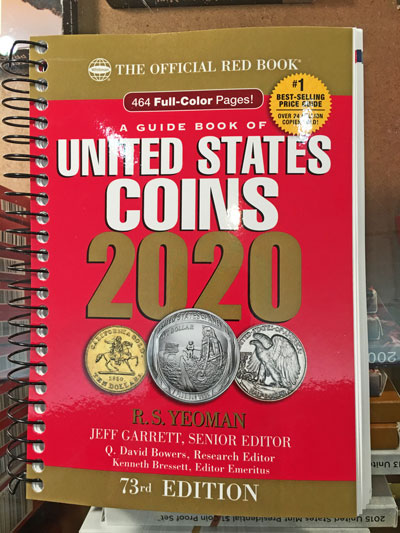
Dealers offered one of the most used reference books for numismatists, the new Official Red Book for 2020, published by Whitman Publishing Company.
On their web site, Whitman describes the book as:
"The Official Red Book - A Guide Book of United States Coins - is 73 Years young and going strong. Collectors around the country love the book’s grade-by-grade values, auction records, historical background, detailed specifications, high-resolution photographs, and accurate mintage data.
"How rare are your coins? How much are they worth? The Red Book tells you, covering everything from early colonial copper tokens to hefty Old West silver dollars and dazzling gold coins.
"You’ll find 32,500+ prices for more than 7,600 coins, tokens, medals, sets, and other collectibles. You’ll also round out your education in commemoratives, Proof and Mint coins, error coins, Civil War tokens, Confederate coins, private gold, and all the latest National Park quarters, Presidential and Native American dollars, Lincoln cents, and more.
On their web site, Whitman describes the book as:
"The Official Red Book - A Guide Book of United States Coins - is 73 Years young and going strong. Collectors around the country love the book’s grade-by-grade values, auction records, historical background, detailed specifications, high-resolution photographs, and accurate mintage data.
"How rare are your coins? How much are they worth? The Red Book tells you, covering everything from early colonial copper tokens to hefty Old West silver dollars and dazzling gold coins.
"You’ll find 32,500+ prices for more than 7,600 coins, tokens, medals, sets, and other collectibles. You’ll also round out your education in commemoratives, Proof and Mint coins, error coins, Civil War tokens, Confederate coins, private gold, and all the latest National Park quarters, Presidential and Native American dollars, Lincoln cents, and more.
"Articles on investing, grading coins, and detecting counterfeits will make you a savvy collector; and entertaining essays on the history of American coinage, shipwrecks and hoards, and the modern rare-coin market give you an inside look at 'the hobby of kings.'
"These are just some of the features of the informative, entertaining, invaluable Red Book-the world’s best-selling coin price guide (more than 24 million copies sold)."
Though there are many reference books for coin collectors, the Red Book provides much of the information needed for both beginning and experienced collectors.
"These are just some of the features of the informative, entertaining, invaluable Red Book-the world’s best-selling coin price guide (more than 24 million copies sold)."
Though there are many reference books for coin collectors, the Red Book provides much of the information needed for both beginning and experienced collectors.
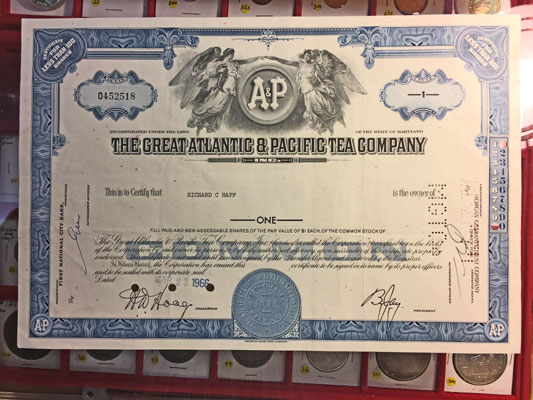
Do you remember the A&P grocery stores? Even though they were not as prolific in the south as in the northern states, quite a few of the stores offered their services in the area several years ago.
Alas, they are no more, dissolving their assets in 2015.
From the Old Main Artifacts web site, they describe the business:
"The Great Atlantic & Pacific Tea Company, also known as the Great American Tea Company, has a fascinating history, starting as a humble New York tea shop and growing to become the largest retailer in the world, followed by its precipitous decline into antiquated obscurity.
Alas, they are no more, dissolving their assets in 2015.
From the Old Main Artifacts web site, they describe the business:
"The Great Atlantic & Pacific Tea Company, also known as the Great American Tea Company, has a fascinating history, starting as a humble New York tea shop and growing to become the largest retailer in the world, followed by its precipitous decline into antiquated obscurity.
Starting as a leather business in 1858, it became a tea business in 1860 and slowly added other products to eventually become the largest grocery store chain in America.
This stock certificate, which notes in the upper corners "Certificate for Less Than 100 Shares," represents one share in the company at the par value of one dollar dated March 28, 1966.
The certificate shows a seal at the bottom with the company incorporating in 1925 in the state of Maryland.
Having started in New York, perhaps it became advantageous to move the corporate functions to Maryland.
One wonders if this gentlemen gained any value if/when he sold his one share of stock.
This stock certificate, which notes in the upper corners "Certificate for Less Than 100 Shares," represents one share in the company at the par value of one dollar dated March 28, 1966.
The certificate shows a seal at the bottom with the company incorporating in 1925 in the state of Maryland.
Having started in New York, perhaps it became advantageous to move the corporate functions to Maryland.
One wonders if this gentlemen gained any value if/when he sold his one share of stock.
"The A&P revolutionized how people bought their groceries, from buying bulk goods to buying branded products.
"And it revolutionized how retailers operated, pioneering the practice of store branded products and paving the way for retailers to dictate low prices from manufacturers and sell in the volume necessary to remain profitable, creating the template for companies like Walmart to follow."
"And it revolutionized how retailers operated, pioneering the practice of store branded products and paving the way for retailers to dictate low prices from manufacturers and sell in the volume necessary to remain profitable, creating the template for companies like Walmart to follow."
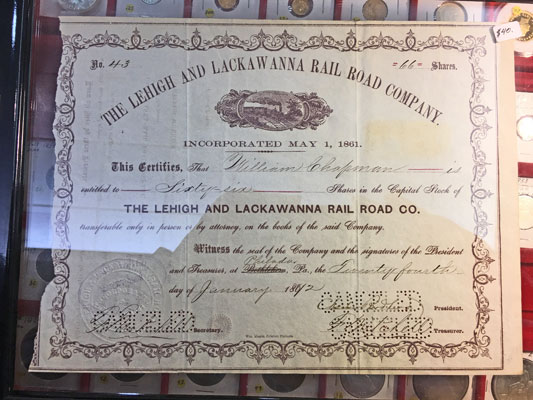
"This company was incorporated, by special act of the Pennsylvania Legislature, to build a road from Bethlehem, Pennsylvania, to Stroudsburg, Pennsylvania, an estimated distance of 36 miles.
"When the road was completed from Bethlehem to Chapman, 15 miles, it was leased to the Lehigh and Susquehanna Railroad Company, to be by them operated at cost; but, up to the last year, the road has not been able to earn enough over and above operating expenses to pay the interest on its bonded debt, and it cannot be regarded as a valuable acquisition to the lessees.
"When the road was completed from Bethlehem to Chapman, 15 miles, it was leased to the Lehigh and Susquehanna Railroad Company, to be by them operated at cost; but, up to the last year, the road has not been able to earn enough over and above operating expenses to pay the interest on its bonded debt, and it cannot be regarded as a valuable acquisition to the lessees.
"According to the latest official returns, the financial condition of the company is as follows: capital stock authorized by law, $1,000,000; capital stock subscribed and actually paid in, $375,100; funded debt, first mortgage bonds, maturing February 1, 1897, $300,000 : total liabilities, represented by stock and debt, $675,100.
"Per contra, cost of construction, $675,100.
Receipts for year ending December 31, 1873, amounted to $42,386.93, derived from the following sources: from passengers, $5906.60; from freight, $36,091.80; from mail and express, $388.53.
"Expenses for the same period were $29,472.21, distributed as follows: for maintenance of way and structures, $13,471.23; for conducting transportation, $15,239.68; for municipal and State taxes, $761.30.
"Excess of receipts over expenditures, $12,914.72."
From Poor's Railroad Manual of 1889:
"Line of Road.- Bethlehem, Pa., to Wind Gap, Pa: 25 miles. Sidings, 5.07 miles. Gauge, 4 ft. 8.5 in. Rail (steel, 14 miles), 50 and 56 lbs. Road opened 1867.
"Per contra, cost of construction, $675,100.
Receipts for year ending December 31, 1873, amounted to $42,386.93, derived from the following sources: from passengers, $5906.60; from freight, $36,091.80; from mail and express, $388.53.
"Expenses for the same period were $29,472.21, distributed as follows: for maintenance of way and structures, $13,471.23; for conducting transportation, $15,239.68; for municipal and State taxes, $761.30.
"Excess of receipts over expenditures, $12,914.72."
From Poor's Railroad Manual of 1889:
"Line of Road.- Bethlehem, Pa., to Wind Gap, Pa: 25 miles. Sidings, 5.07 miles. Gauge, 4 ft. 8.5 in. Rail (steel, 14 miles), 50 and 56 lbs. Road opened 1867.
The next collectible is another stock certificate for a small railroad.
From the American Railroad Manual for the United States and the Dominion published in 1874:
From the American Railroad Manual for the United States and the Dominion published in 1874:
Philadelphia and Reading Railroad Company
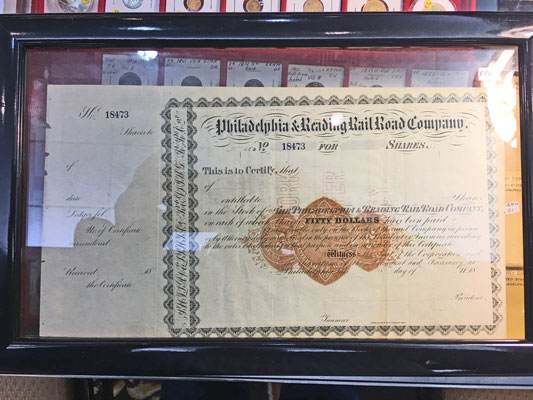
"The Reading Company, usually called the Reading Railroad, officially the Philadelphia and Reading Rail Road and then the Philadelphia and Reading Railway until 1924, operated in southeast Pennsylvania and neighboring states.
"Until the decline in anthracite loadings in the Coal Region after World War II it was one of the most prosperous corporations in the United States.
"Reduced coal traffic coupled with highway competition and short hauls forced it into bankruptcy in the 1970s. The railroad was merged into Conrail in 1976, but the corporation lasted into 2000, disposing of real estate holdings.
"Until the decline in anthracite loadings in the Coal Region after World War II it was one of the most prosperous corporations in the United States.
"Reduced coal traffic coupled with highway competition and short hauls forced it into bankruptcy in the 1970s. The railroad was merged into Conrail in 1976, but the corporation lasted into 2000, disposing of real estate holdings.
Do you know your Monopoly railroads? Take a look at the one represented by this stock certificate.
From The Full Wiki web site:
From The Full Wiki web site:
"Since the railroad served Atlantic City, New Jersey (via subsidiary The Atlantic City Railroad), Reading Railroad is a property in the board game Monopoly.
"The Philadelphia and Reading Railroad (P&R) was one of the first railroads constructed in the United States. Along with the Little Schuylkill, a horse-drawn railroad in the Schuylkill River Valley, it formed the earliest components of what became the Reading Company.
"Primarily, the P&R was constructed to haul anthracite coal from the mines in northeastern Pennsylvania's Coal Region to Philadelphia.
"The Philadelphia and Reading Railroad (P&R) was one of the first railroads constructed in the United States. Along with the Little Schuylkill, a horse-drawn railroad in the Schuylkill River Valley, it formed the earliest components of what became the Reading Company.
"Primarily, the P&R was constructed to haul anthracite coal from the mines in northeastern Pennsylvania's Coal Region to Philadelphia.
1909-S VDB Lincoln Cent
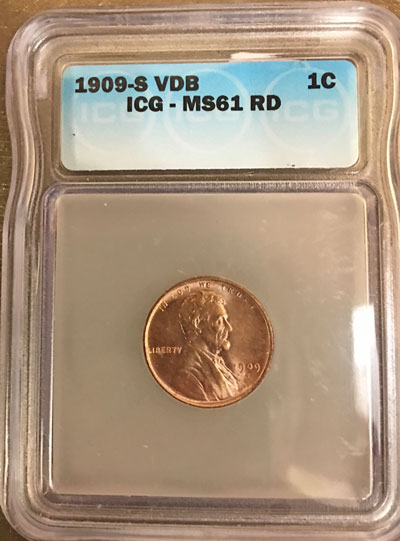
The Philadelplia mint location produced the majority, over 27 million, of the 1909 VDB coins, however San Francisco also struck just under 500,000.
Soon, the design changed, removing the initials from the reverse and not returning them to the coin until 1918 on the obverse.
NGC (Numismatic Guaranty Corporation) describes the coin:
"For generations of American coin collectors, this issue has been the coin highest on their want lists. It has the lowest mintage of any Lincoln Cent issued for circulation, and examples were rarely found in change.
"Had this low figure occurred a few years into the series instead of at the very beginning, examples would be truly rare in Mint State. As it is, many were saved at the time of issue because of the controversial initials V.D.B. The public assumed, incorrectly, that this variety would be withdrawn. The narrow spread over so many grades confirms that there is little difference in rarity below the gem level.
Soon, the design changed, removing the initials from the reverse and not returning them to the coin until 1918 on the obverse.
NGC (Numismatic Guaranty Corporation) describes the coin:
"For generations of American coin collectors, this issue has been the coin highest on their want lists. It has the lowest mintage of any Lincoln Cent issued for circulation, and examples were rarely found in change.
"Had this low figure occurred a few years into the series instead of at the very beginning, examples would be truly rare in Mint State. As it is, many were saved at the time of issue because of the controversial initials V.D.B. The public assumed, incorrectly, that this variety would be withdrawn. The narrow spread over so many grades confirms that there is little difference in rarity below the gem level.
The first coin this month showcases one of the more desirable Lincoln cents.
After being introduced in 1909, a brouhaha occurred due to the designer's initials being on the reverse of the coin.
After being introduced in 1909, a brouhaha occurred due to the designer's initials being on the reverse of the coin.
"Whatever the facts, the appeal of this issue is undeniable, and no collection of Lincoln Cents is complete without it. Four obverse dies are known from their variable mintmark positions, and knowledge of these dies is key to authenticating this often counterfeited or altered issue."
ICG (Independent Coin Graders) has certified several hundred of the 1909-S VDB coins, however they have only graded 40 in mint state red condition.
This coin is one of two they graded as MS-61 RD.
Not the highest grade, but this is still a nice specimen that can achieve values in the $2000+ range.
ICG (Independent Coin Graders) has certified several hundred of the 1909-S VDB coins, however they have only graded 40 in mint state red condition.
This coin is one of two they graded as MS-61 RD.
Not the highest grade, but this is still a nice specimen that can achieve values in the $2000+ range.
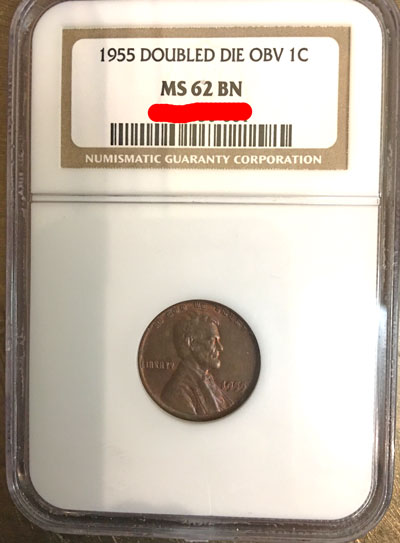
Last month, we had a 1955 Doubled Die Lincoln Cent, this month is a different coin certified by NGC.
They describe the coin:
"This is by far the most dramatic doubled-die variety in United States coinage and certainly the most highly sought. It is believed to have occurred during the fall, when a severe shortage of cents drove the Philadelphia Mint to extreme measures that included working 12-hour days. An estimated 24,000 examples were coined, but this figure is merely a reconstruction that can never be proved
They describe the coin:
"This is by far the most dramatic doubled-die variety in United States coinage and certainly the most highly sought. It is believed to have occurred during the fall, when a severe shortage of cents drove the Philadelphia Mint to extreme measures that included working 12-hour days. An estimated 24,000 examples were coined, but this figure is merely a reconstruction that can never be proved
The value of the collectible increases as more red shows in the coin.
The coins range from the $2800s for the Brown, $3700s for the Red-Brown and $4400s for the Red specimens.
This is a nice coin - regardless of its color.
The coins range from the $2800s for the Brown, $3700s for the Red-Brown and $4400s for the Red specimens.
This is a nice coin - regardless of its color.
1833 Half-Dime Coin

Now, let's take a look at a few half dimes.
NGC certified this 1833 Capped Bust Half Dime as MS-63.
They describe the coin:
"This is another fairly plentiful entry in the Capped Bust Half Dime series. The published mintage includes some dated 1832, but the use of three obverse dies and seven reverses indicates that plenty were minted with the date 1833. Like the example illustrated, many of these coins are poorly struck at their centers.
NGC certified this 1833 Capped Bust Half Dime as MS-63.
They describe the coin:
"This is another fairly plentiful entry in the Capped Bust Half Dime series. The published mintage includes some dated 1832, but the use of three obverse dies and seven reverses indicates that plenty were minted with the date 1833. Like the example illustrated, many of these coins are poorly struck at their centers.
In total, NGC has certified 672 of the 1833 Half Dimes from PrAg (Poor About Good) to MS-67 with 104 of those in the MS-63 grade. They have also graded three additional coins as MSPL (Proof-Like), one as MS-64 PL and two and MS-66 PL.
Across all their grades, NGC provides a broad range of values from $37 for PrAg to over $16,000 for the MS-67.
This 186 years old coin is a very nice specimen in its MS-63 grade.
Across all their grades, NGC provides a broad range of values from $37 for PrAg to over $16,000 for the MS-67.
This 186 years old coin is a very nice specimen in its MS-63 grade.
1860 Half-Dime Coin
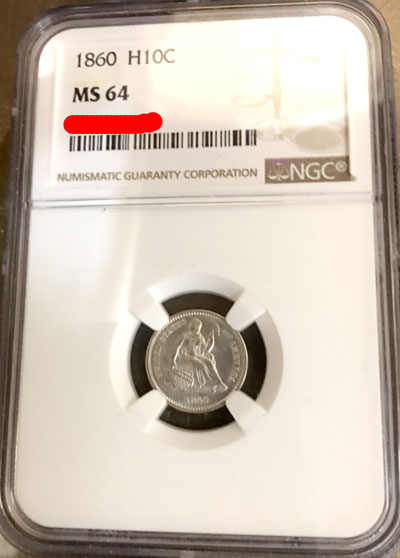
The next half dime from 1860 is an example of the Liberty Seated design.
NGC certified this coin as a MS-64 grade, which they describe as "Average or better strike with several obvious marks or hairlines and other miniscule imperfections."
For this particular coin, they note:
NGC certified this coin as a MS-64 grade, which they describe as "Average or better strike with several obvious marks or hairlines and other miniscule imperfections."
For this particular coin, they note:
"Most 1860(P) half dimes are well struck, and finding a nice example will not be difficult. The only notable variety features a complete repunching of the date clockwise to the first impression, though careful overlapping rendered only the first and last duplicate numbers visible. A minor doubled-die obverse variety features doubling of the legend, but this variety has attracted little attention."
The Philadelphia and New Orleans mint locations produced the 1860 Half Dime.
This example is one of 798,000 circulation strikes from the Philadelphia mint.
NGC has graded 544 of these coins with 146 in the MS-64 grade. They estimate values from $11 (PrAg) to over $11,000 in MS-68 condition.
At MS-64, this 1860 Seated Liberty Half Dime shows the artistry and craftsmanship of the Mint from 159 years ago.
The Philadelphia and New Orleans mint locations produced the 1860 Half Dime.
This example is one of 798,000 circulation strikes from the Philadelphia mint.
NGC has graded 544 of these coins with 146 in the MS-64 grade. They estimate values from $11 (PrAg) to over $11,000 in MS-68 condition.
At MS-64, this 1860 Seated Liberty Half Dime shows the artistry and craftsmanship of the Mint from 159 years ago.
1870 Half Dime Coin

The next coin is another Seated Liberty Half Dime from 1870 graded by NGC as MS-64.
They describe the coin:
"The Philadelphia Mint's output of half dimes more than doubled from the previous, as deposits of silver for coining increased dramatically after 1867. This is the first truly common issue since 1862, and it set the pattern for the last few years of half dime coinage.
They describe the coin:
"The Philadelphia Mint's output of half dimes more than doubled from the previous, as deposits of silver for coining increased dramatically after 1867. This is the first truly common issue since 1862, and it set the pattern for the last few years of half dime coinage.
As for the 1870 Half Dime from Philadelphia, NGC has certified 316 coins with 67 of those in the MS-64 grade.
NGC estimates values for the coin from $11 for the PrAg to over $15,000 for the MS-68 certification.
This MS-64 1870 Seated Liberty Half Dime coin is a nice specimen out of the 535,000 minted for circulation in Philadelphia.
NGC estimates values for the coin from $11 for the PrAg to over $15,000 for the MS-68 certification.
This MS-64 1870 Seated Liberty Half Dime coin is a nice specimen out of the 535,000 minted for circulation in Philadelphia.
Colorful Geological Specimen
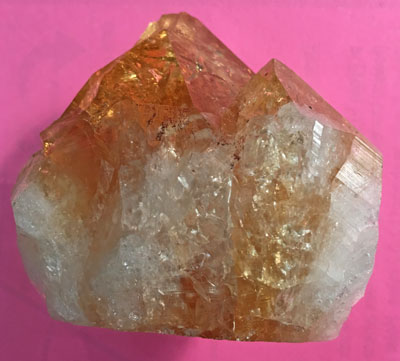

Our last example for April is a nice rock or is it a mineral?
From Wikibooks:
"A mineral is a naturally occurring, inorganic solid with a definite chemical composition and a crystalline structure formed by geological processes.
"A rock is an aggregate of one or more minerals whereas a rock may also include organic remains and mineraloids.
"Some rocks are predominantly composed of just one mineral.
"For example, limestone is a sedimentary rock composed almost entirely of the mineral calcite.
"Other rocks contain many minerals, and the specific minerals in a rock can vary widely.
"Some minerals, like quartz, mica or feldspar are common, while others have been found in only one or two locations worldwide.
From Wikibooks:
"A mineral is a naturally occurring, inorganic solid with a definite chemical composition and a crystalline structure formed by geological processes.
"A rock is an aggregate of one or more minerals whereas a rock may also include organic remains and mineraloids.
"Some rocks are predominantly composed of just one mineral.
"For example, limestone is a sedimentary rock composed almost entirely of the mineral calcite.
"Other rocks contain many minerals, and the specific minerals in a rock can vary widely.
"Some minerals, like quartz, mica or feldspar are common, while others have been found in only one or two locations worldwide.
"Sedimentary rocks such as limestone or shale are hardened sediment with sandy or clay-like layers (strata). They are usually brown to gray in color and may have fossils and water or wind marks."
"Metamorphic rocks such as marble are tough, with straight or curved layers (foliation) of light and dark minerals. They come in various colors and often contain glittery mica."
Since we forgot what the dealer told us about this rock or mineral, we'll just enjoy its beauty.
"Metamorphic rocks such as marble are tough, with straight or curved layers (foliation) of light and dark minerals. They come in various colors and often contain glittery mica."
Since we forgot what the dealer told us about this rock or mineral, we'll just enjoy its beauty.
"Rolling Stock furnished by Central RR. Co., of New Jersey.
"Operations for year ending December 31, 1888.- Train mileage - passenger, 39,520; Freight, 19,588 - total, 59,108 miles. Passengers carried one mile, 836,039. Tons freight conveyed, 70,729; moved one mile, 1,315,946.
"Earnings - passenger, $18,796.98; freight, $40,045.70 ; mail, express, etc., $2,540.32- total, $61,383. Expenses not reported. Paid interest on 1st mortgage bonds, $7,000.
"Financial Statement, December 81, 1888.- Capital stock (authorized, $1,000,000; $50- shares), $370,500; funded debt, 1st mortgage 7 per cent. 30-year bonds, due December 1, 1907, $100,000-total stock and bonds, $470,500. There are no second mortgage bonds outstanding."
This stock certificate represented 66 shares purchased on January 24, 1872 by Mr. William Chapman.
One wonders, did he recoup his investment plus interest?
"Operations for year ending December 31, 1888.- Train mileage - passenger, 39,520; Freight, 19,588 - total, 59,108 miles. Passengers carried one mile, 836,039. Tons freight conveyed, 70,729; moved one mile, 1,315,946.
"Earnings - passenger, $18,796.98; freight, $40,045.70 ; mail, express, etc., $2,540.32- total, $61,383. Expenses not reported. Paid interest on 1st mortgage bonds, $7,000.
"Financial Statement, December 81, 1888.- Capital stock (authorized, $1,000,000; $50- shares), $370,500; funded debt, 1st mortgage 7 per cent. 30-year bonds, due December 1, 1907, $100,000-total stock and bonds, $470,500. There are no second mortgage bonds outstanding."
This stock certificate represented 66 shares purchased on January 24, 1872 by Mr. William Chapman.
One wonders, did he recoup his investment plus interest?
"The original P&R mainline extended south from the mining town of Pottsville to Reading and then onward to Philadelphia, following the gently graded banks of the Schuylkill River for nearly all of the 93 mile journey.
"The P&R mainline had the distinction of being, upon its 1843 completion, the first double track main line in the United States.
"On April 1, 1976, the Reading Company sold its current railroad interests to the newly formed Consolidated Railroad Corporation (Conrail), leaving it with 650 real estate assets, some coal properties, and 52 abandoned rights-of-ways.
"It had sold 350 of the real estate tracts by the time it left bankruptcy in 1980.
"The company sold its last railroad-related asset, the Reading Terminal Headhouse, in 1993."
This stock certificate was never purchased, however it provides an excellent example of an early stock transaction.
"The P&R mainline had the distinction of being, upon its 1843 completion, the first double track main line in the United States.
"On April 1, 1976, the Reading Company sold its current railroad interests to the newly formed Consolidated Railroad Corporation (Conrail), leaving it with 650 real estate assets, some coal properties, and 52 abandoned rights-of-ways.
"It had sold 350 of the real estate tracts by the time it left bankruptcy in 1980.
"The company sold its last railroad-related asset, the Reading Terminal Headhouse, in 1993."
This stock certificate was never purchased, however it provides an excellent example of an early stock transaction.
"Examples are quite scarce in Mint State, and fully red gems are very rare. The overall poor quality of 1955(P) cents in general certainly contributed to the lack of high grade survivors. Also a factor was the coin hobby's slow reaction to the desirability of this variety, which sold for a very modest premium until about 1960, when it finally took off in a big way."
To date, NGC has certified 529 of the MS-62 BN or Mint State 62 Brown doubled die cents.
Comparatively, they have only graded 48 MS-62 RB (Red-Brown) and three MS-62 RD (Red).
To date, NGC has certified 529 of the MS-62 BN or Mint State 62 Brown doubled die cents.
Comparatively, they have only graded 48 MS-62 RB (Red-Brown) and three MS-62 RD (Red).
"The same press might coin half dimes one day, dimes the next, and then half dimes again the day after that. Thus, the dies were frequently removed from the press, shelved and then reinstalled. Little care was taken to use the same die pair each time, with the result that the known dies for this date produced a total of 10 marriages.
"Varieties LM-2 and LM-5 are the rare ones for 1833, with LM-6 being a little less so. LM-1 (photos) and LM-8 are slightly scarce, while the remaining marriages are all common. Illustrated is LM-4.1, the decimal numeral indicating that this is the earliest of three die state for that marriage."
"Varieties LM-2 and LM-5 are the rare ones for 1833, with LM-6 being a little less so. LM-1 (photos) and LM-8 are slightly scarce, while the remaining marriages are all common. Illustrated is LM-4.1, the decimal numeral indicating that this is the earliest of three die state for that marriage."
"The legend UNITED STATES OF AMERICA was transferred to the obverse of the dime and half dime beginning in 1860. The simple wreath utilized previously was replaced with a much more elaborate one that did not provide sufficient space for the former legend. J. B. Longacre refined the R. B. Hughes figure of Liberty from 1840 for the obverse, and he is generally credited with the wreath device, as well. Some claim, however, may be made for A. C. Paquet having created this wreath, as the tall, narrow lettering used on both sides is characteristic of his work.
"Despite a relatively modest mintage, this issue is plentiful across all grades through MS 66. The novelty of this design probably accounts for such availability, as there were at least several hundred active collectors of United States coins by 1860.
"Despite a relatively modest mintage, this issue is plentiful across all grades through MS 66. The novelty of this design probably accounts for such availability, as there were at least several hundred active collectors of United States coins by 1860.
"The example illustrated shows weakness at the lower part of the shield and the upper left portion of the wreath. These design elements were directly opposite one another, and the dies frequently failed to fill on coins of this type."
Though the Red Book shows both Philadelphia and San Francisco produced the 1870 Half Dime coins, in reality, Philadelphia struck almost all of them.
After shipping dies west, no coins from San Francisco became circulated. However, in 1978, someone found an 1870S specimen. Very rare indeed.
Should you find an 1870S, the value would most likely be in the seven digit range.
Though the Red Book shows both Philadelphia and San Francisco produced the 1870 Half Dime coins, in reality, Philadelphia struck almost all of them.
After shipping dies west, no coins from San Francisco became circulated. However, in 1978, someone found an 1870S specimen. Very rare indeed.
Should you find an 1870S, the value would most likely be in the seven digit range.
"An easier explanation would be that a rock can contain minerals whereas a mineral has a unique specific makeup and always has the same composition if it's the same mineral.
"They are also both mined from the ground."
More identification details can be found on ThoughtCo's web site:
"Rock Identification Tips
"First, decide whether your rock is igneous, sedimentary or metamorphic.
"Igneous rocks such as granite or lava are tough, frozen melts with little texture or layering. Rocks like these contain mostly black, white and/or gray minerals."
"They are also both mined from the ground."
More identification details can be found on ThoughtCo's web site:
"Rock Identification Tips
"First, decide whether your rock is igneous, sedimentary or metamorphic.
"Igneous rocks such as granite or lava are tough, frozen melts with little texture or layering. Rocks like these contain mostly black, white and/or gray minerals."
